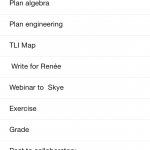Two classroom management challenges came up recently in my engineering classes. In the first, two friends were horsing around and did some minor, easy to fix damage to their projects. Each claimed the other had started it. In the second, I assigned two short assignments that could be completed in a single period, even though I said they could hand them in the next day. Most students worked quietly getting the work done. But at one table everyone was socializing instead of working. So, I said that everyone in the class had to get both assignments in by the end of the period or get a zero. One student from the off-task table grew irate. “This is BS! We can’t do two assignments in one period! That’s ridiculous! That’s BS! I don’t want to be in this class! Can I go to the counselor to get my schedule changed?!?” (He did say, “BS,” not the words the letters stand for.)
A year ago, I would have managed each case differently than I did this year. In the first case, I would have hit the students with, “Hey, keeping something going is just as bad as starting it!” Then, I’d have likely removed them from the lab work and maybe timed them out with nearby colleagues.
In the second case, I’d have sensed the need that I had to win the fight. Accordingly, I would have matched his tone, and when his rose in response, so would mine. It would have ended with me timing him out with a nearby colleague and telling him dismissively that he’d get a zero if he didn’t finish. I would have documented the incident and called home.
But this year I’ve added a couple new tools to my belt that I’d like to share. They come from Thank Your For Arguing: What Aristotle, Lincoln, and Homer Simpson Can Teacher Us About the Art of Persuasion, by Jay Heinrichs. The author explains how the rhetorical devices of Aristotle, Cicero, and other ancients are as applicable today as ever. I’ve learned, for example, that there’s a difference between a fight and an argument. You fight to win; you argue to reach consensus. Also, the tense in which you argue makes a difference. You argue in the past tense to establish blame, in the present tense to establish values, and in the future tense to influence decisions. Furthermore, the path through an argument begins with mediating the adversary’s (or audience’s) emotions, then their thoughts, and finally their actions.
Heinrichs begins his book with a story about a morning when there was no toothpaste in the bathroom. Enraged, he demanded to know who had used the last of the tube without replacing it. His son offered that that wasn’t really the question he should be asking. Rather, he should be asking how could they prevent it from happening again.
In the class with the kids who were fighting over who was to blame for the damaged projects, I followed that model explicitly. I told them, “You’re fighting about the wrong thing. Instead of trying to convince me who started it, you need to show me how you’re going to share responsibility to keep it from happening again.” Realizing that no one was going to get in trouble shifted the mood along with the content of the discussion. We came to some amiable agreements and everyone was happy. However, I’d be remiss if I didn’t relate that as I walked away I heard one take a parting shot at the other, “You still started it,” he whispered. Nonetheless, I’ll call it a win.
The challenge with the boy was more complicated and my approach more nuanced. First, the confrontation was being played out in front of the class, and second, he had acted out once before and I knew the arc his outburst would follow if I kept my cool. Accordingly, I realized that I wasn’t just arguing with him, but also trying to convince the class not to buy into what he was saying. I asked myself – I can defeat him, but is that really what I’m after?
I pointed out, ostensibly to him but actually to the rest of the class, that some students had already finished the work. Still mad, he asked again if he could go to the counselor and change his class. I said no, instructed him to return to his seat, and disengaged. He kept protesting, but I knew from the previous experience that without a willing antagonist, his emotions would drain and his script run out. Furthermore, by not fighting with him, the whole thing bored the rest of the class, so they kept on working – including those at the table where the disruption had begun. He had one more mini-burst about a question he didn’t understand, but responded well, if unhappily, to my coaching.
As the clock wound down, I told the class they could get their work to me any time before the end of school. Later in the day I passed the student in a breezeway and asked if we were going to be OK the next day. It took a moment for him to remember why we might not and then said, sans sarcasm, “Oh, yeah, sure.”
I’m not saying I’ve found the cure for all classroom management challenges. Nor have I mastered the art of arguing with a student. But being mindful of the outcomes I care about and deliberately applying the lessons from Thank You for Arguing has so far reaped enough rewards to keep at it.










Comments 2
Thank you for being vulnerable and sharing this. It gives me food for thought as I engage with my students this week!
Interesting new concept! I will have to check out the book.